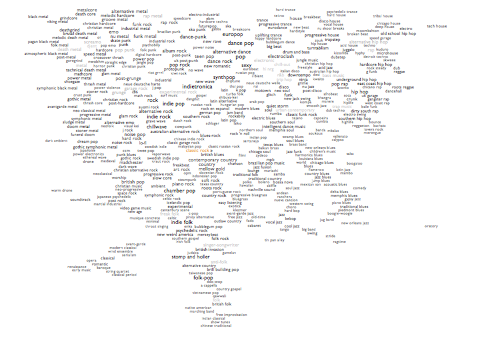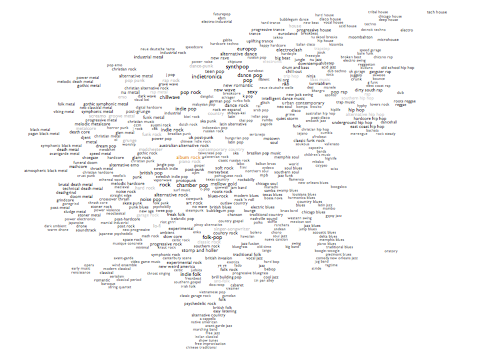¶ Noise Adjustments · 31 May 2013 listen/tech
Every Noise at Once began as a byproduct of some data experimentation I was doing at work at the Echo Nest, and although it has taken on something of its own life, as well, the underlying data experimentation continues, and I keep making new maps and plot to help myself think about how we can usefully describe music in numbers.
As I keep emphasizing, the map isn't a data visualization in a strict sense. But it does arise from scatter-plots. In the first versions, the axes went from electric (left) to acoustic (right), and from more sonic density (top) to more sonic spikiness (bottom). After a while I flipped these to be electric (top) to acoustic (bottom), and from more sonic density (left) to more sonic spikiness (right). Both of these worked pretty well, with obvious clusters of things we know are similar in the real world.
Both also had plenty of micro-level oddities. These are just 2 of the 10 dimensions in our actual analyses, and even with 10 dimensions we're not yet always able to distinguish conclusively between things that we as human listeners think of as patently distinct. And the data shifts daily, and the math that bumps things around so we can read them injects its own sort of erosional contours into the process. So things happen, like "intelligent dance music" ending up sandwiched between "southern soul" and "memphis soul". I don't really mind this. At least we got "southern soul" and "memphis soul" close to each other.
But I keep fiddling with the numbers, and with today's map update both axes are now using different calculations to try to get at the same basic ideas more accurately. Or more expressively, maybe.
The acoustic/electric axis (down to up) is now more of an organic/mechanical axis. This doesn't make much difference at the bottom, as the most acoustic forms also tend to be pretty organic. But if anybody comes up with a new genre of robots playing Michael Nyman soundtracks on dulcimers, we now ought to be able to distinguish it from bluegrass. And where the old acoustic/electric scale had both metal and techno forms across the very top, the new organic/mechanical scale recognizes that there's still a lot of organism in highly electrified metal, and reserves the top of the scale for house/techno/synthpop forms that are driven by both synthesized timbres and rhythms. Plus now "futurepop" is top center, and if our dreams of the future don't represent some kind of exaggerated caricature of the present, then what's the point?
The new left-right axis is, similarly, a new attempt to better express the same dense/spiky idea, which I've started describing to myself as "bounciness". At the far left, atmospheric metal and ambient/drone forms are definitively unbouncy, and at the far right, reggae- and hip-hop-derived forms are fine exemplars of what I mean by bouncy or spiky. I didn't know until one of my co-workers added it recently that "bounce" was a genre, and it scores highly on my new bounciness measure, so that's good.
Combine these two axis-changes and the result is that the top left corner of the map kind of rotates, squishily but with a certain arboreal elegance, 45 degrees counter-clockwise:
It's hard to imagine that anybody but me really cares about this, in itself. But I think it does a very slightly better overall job of genre-positioning, which is at least partially the point. So now "intelligent dance music" moves up towards chill-out and turntablism, a little farther from old souls. Surf music and experimental rock pull apart (surf up, experimental rock down). The dense and electric, but organic, stoner metal and sludge metal move down, and the similarly dense but more synthetic gothic metal and gothic symphonic metal move up, and the former no longer fall between the latter. Reggaeton moves up closer to moombahton.
Not that there aren't some new curiosities, too. Worship and grunge end up together, but "worship" is a culturally defined genre with a mishmash of musical styles, so it's likely to wander around a bit randomly in any audio-based map (it was next to british pop before). New age ends up between punk blues and garage rock in the new map, which probably is not a juxtraposition with exploratory value, but it was next to video game music before, so whatever. Schlager and breakcore is a similarly hilarious pairing, but in the cluster with german pop, turbo folk and k pop it kind of starts to make sense. Riot grrrl pulls away from the fringes of metal towards lo fi.
So there we are. Minor improvements, maybe. Some days that's what I accomplish. I like to think of it as craftsmanship. Because that definitely sounds better than "fidgeting".
PS: If you don't care about all this, but do care about discovering music, this update also adds the 60s French pop genre ye ye, the Brazilian dance styles pagode and forro, the Scottish traditional form pipe band, and the drum-and-bass variations liquid funk, glitch hop and wonky. And if you care about listening to music, this update also fixes a bug I hadn't noticed that caused only the most prominent bands in each genre to get clickable song-samples, so now all but the really obscure ones ought to have songs again.
As I keep emphasizing, the map isn't a data visualization in a strict sense. But it does arise from scatter-plots. In the first versions, the axes went from electric (left) to acoustic (right), and from more sonic density (top) to more sonic spikiness (bottom). After a while I flipped these to be electric (top) to acoustic (bottom), and from more sonic density (left) to more sonic spikiness (right). Both of these worked pretty well, with obvious clusters of things we know are similar in the real world.
Both also had plenty of micro-level oddities. These are just 2 of the 10 dimensions in our actual analyses, and even with 10 dimensions we're not yet always able to distinguish conclusively between things that we as human listeners think of as patently distinct. And the data shifts daily, and the math that bumps things around so we can read them injects its own sort of erosional contours into the process. So things happen, like "intelligent dance music" ending up sandwiched between "southern soul" and "memphis soul". I don't really mind this. At least we got "southern soul" and "memphis soul" close to each other.
But I keep fiddling with the numbers, and with today's map update both axes are now using different calculations to try to get at the same basic ideas more accurately. Or more expressively, maybe.
The acoustic/electric axis (down to up) is now more of an organic/mechanical axis. This doesn't make much difference at the bottom, as the most acoustic forms also tend to be pretty organic. But if anybody comes up with a new genre of robots playing Michael Nyman soundtracks on dulcimers, we now ought to be able to distinguish it from bluegrass. And where the old acoustic/electric scale had both metal and techno forms across the very top, the new organic/mechanical scale recognizes that there's still a lot of organism in highly electrified metal, and reserves the top of the scale for house/techno/synthpop forms that are driven by both synthesized timbres and rhythms. Plus now "futurepop" is top center, and if our dreams of the future don't represent some kind of exaggerated caricature of the present, then what's the point?
The new left-right axis is, similarly, a new attempt to better express the same dense/spiky idea, which I've started describing to myself as "bounciness". At the far left, atmospheric metal and ambient/drone forms are definitively unbouncy, and at the far right, reggae- and hip-hop-derived forms are fine exemplars of what I mean by bouncy or spiky. I didn't know until one of my co-workers added it recently that "bounce" was a genre, and it scores highly on my new bounciness measure, so that's good.
Combine these two axis-changes and the result is that the top left corner of the map kind of rotates, squishily but with a certain arboreal elegance, 45 degrees counter-clockwise:
It's hard to imagine that anybody but me really cares about this, in itself. But I think it does a very slightly better overall job of genre-positioning, which is at least partially the point. So now "intelligent dance music" moves up towards chill-out and turntablism, a little farther from old souls. Surf music and experimental rock pull apart (surf up, experimental rock down). The dense and electric, but organic, stoner metal and sludge metal move down, and the similarly dense but more synthetic gothic metal and gothic symphonic metal move up, and the former no longer fall between the latter. Reggaeton moves up closer to moombahton.
Not that there aren't some new curiosities, too. Worship and grunge end up together, but "worship" is a culturally defined genre with a mishmash of musical styles, so it's likely to wander around a bit randomly in any audio-based map (it was next to british pop before). New age ends up between punk blues and garage rock in the new map, which probably is not a juxtraposition with exploratory value, but it was next to video game music before, so whatever. Schlager and breakcore is a similarly hilarious pairing, but in the cluster with german pop, turbo folk and k pop it kind of starts to make sense. Riot grrrl pulls away from the fringes of metal towards lo fi.
So there we are. Minor improvements, maybe. Some days that's what I accomplish. I like to think of it as craftsmanship. Because that definitely sounds better than "fidgeting".
PS: If you don't care about all this, but do care about discovering music, this update also adds the 60s French pop genre ye ye, the Brazilian dance styles pagode and forro, the Scottish traditional form pipe band, and the drum-and-bass variations liquid funk, glitch hop and wonky. And if you care about listening to music, this update also fixes a bug I hadn't noticed that caused only the most prominent bands in each genre to get clickable song-samples, so now all but the really obscure ones ought to have songs again.


